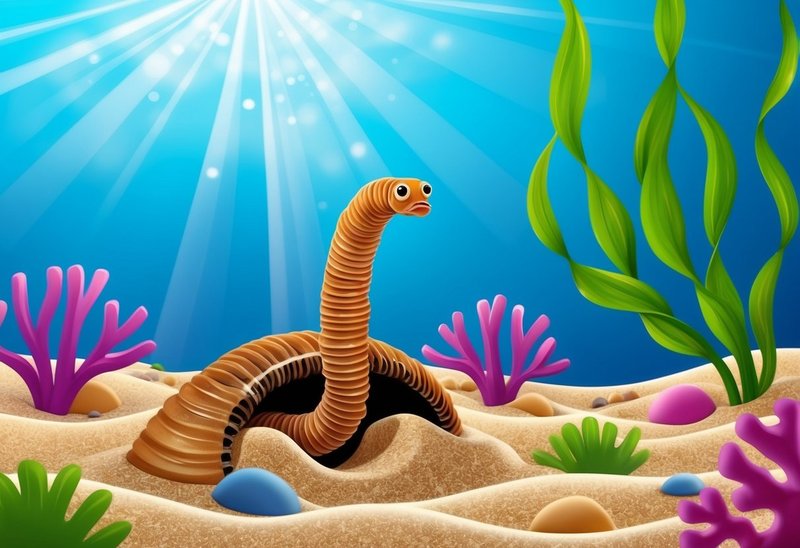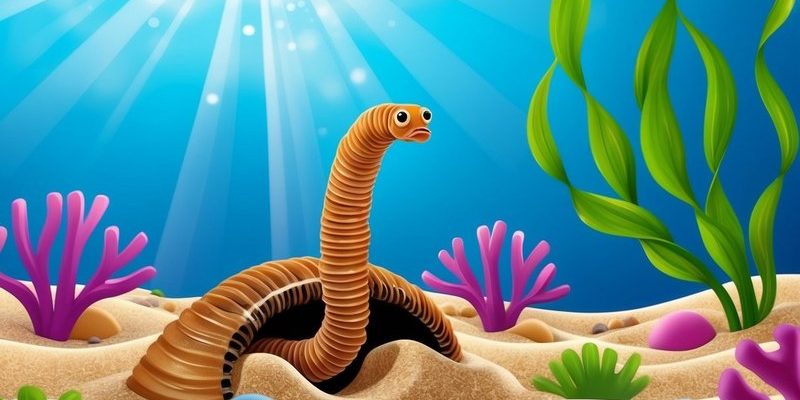
Bobbit worms, scientifically known as *Eunice aphroditois*, are not just any sea creatures. They are long, segmented worms that can reach impressive lengths—some even stretch over three feet! But it’s not just their size that makes them interesting. These worms play a vital role in the food web, helping maintain the balance of marine life. So, let’s dive in and explore how bobbit worms fit into this underwater puzzle.
What Are Bobbit Worms?
Before we delve into their role in the food chain, it’s essential to know a bit about bobbit worms themselves. These creatures are part of the polychaete family, which are segmented worms. They primarily live in burrows on the ocean floor, blending in with their surroundings. You might not notice them at first, but they are masters of camouflage!
Bobbit worms are known for their elongated bodies and sharp jaws. They’re typically found in warm, tropical waters, but their habitats can range from coral reefs to sandy bottoms. When they’re not out hunting, they stay hidden, peeking out only to ambush unsuspecting prey. This ambush tactic is what makes them fascinating predators and pivotal players in marine ecosystems.
Interestingly, these worms can regenerate lost segments, which is like having a superpower! If a fish nibbles off part of their body, they can grow it back. This resilience allows them to thrive even in challenging conditions, making them an enduring part of their environment.
The Bobbit Worm’s Role as a Predator
Now, let’s talk about the bobbit worm’s role as a predator in the marine food chain. Here’s the thing: they are not picky eaters. These worms eat a variety of organisms, from small fish to crustaceans. When prey wanders too close, the bobbit worm strikes with lightning speed, using its powerful jaws to capture and consume its meal.
So, why is this important? Well, bobbit worms help control the population of other marine species. By keeping their numbers in check, they prevent any one species from dominating the ecosystem. This balance is crucial for the health of the ocean habitat. Without predators like the bobbit worm, we could see overpopulation, which can lead to a decline in biodiversity.
But there’s more to the story. When bobbit worms consume prey, they also contribute to nutrient cycling in the ocean. Their waste provides essential nutrients for other organisms, supporting the growth of plants and smaller marine life. It’s a classic case of “what goes around, comes around.”
How Bobbit Worms Impact the Marine Food Web
Let’s take a closer look at how bobbit worms fit into the *marine food web*. You see, the food web is a complex network of who-eats-who, and every creature has a place in it. Bobbit worms are often considered **secondary consumers**, meaning they eat primary consumers (like small fish and invertebrates) but are also prey for larger animals.
In their role as prey, bobbit worms are part of the diet for larger predators, such as fish and some seabirds. This adds another layer to their importance in the food web. By being both predators and prey, they help maintain equilibrium in the ecosystem. This dual role keeps populations balanced—if bobbit worms were to disappear, it could create a ripple effect that impacts many other species.
Moreover, the presence of bobbit worms can indicate the health of their environment. A thriving bobbit worm population suggests a balanced ecosystem, whereas a decline could signal problems. It’s a reminder of how interconnected marine life is and how each species contributes to the bigger picture.
Bobbit Worms and Their Habitat: A Complex Relationship
The habitat of bobbit worms is just as fascinating as the worms themselves. They create complex burrows in the ocean floor, which can serve as homes for various other marine organisms. These burrows offer shelter and can even attract other species looking for a safe space.
This relationship is essential for many marine animals, especially those seeking refuge from predators. Some fish might hide in or near bobbit worm burrows, knowing that these environments provide safety. In this way, bobbit worms indirectly support a community of marine life, enhancing biodiversity.
Additionally, the structure of their burrows helps with sediment stability. By digging and maintaining these tunnels, bobbit worms create habitats that benefit many other organisms. It’s a bit like an architect designing a building—bobbit worms contribute to the structure of the ocean floor, allowing other species to thrive alongside them.
The Role of Bobbit Worms in Marine Ecosystem Health
Healthy ecosystems are vital for our planet, and bobbit worms play a role in that health. By contributing to nutrient cycling and controlling prey populations, these worms help keep marine environments thriving. They’re part of a delicate balance that sustains life in the ocean.
You might be wondering how human activity affects these worms and their role in the ecosystem. Unfortunately, factors like pollution and habitat destruction can have negative impacts on bobbit worm populations. If their habitats are compromised, it not only affects the worms but also all the species that rely on them.
Marine conservation is crucial for the survival of bobbit worms and the overall health of ocean ecosystems. Protecting their habitats means protecting the myriad of life forms that depend on them. It’s a vital step in ensuring our oceans remain vibrant and full of biodiversity.
The Future of Bobbit Worms and Conservation Efforts
Looking ahead, the future of bobbit worms is closely tied to our efforts in marine conservation. As we become more aware of the importance of these creatures and their roles in the food chain, conservationists are pushing for protections that help preserve their habitats.
Restoration projects and marine protected areas are some ways we can help. By creating safe spaces for marine life, including bobbit worms, we can support the entire ecosystem. Every effort counts, from clean-up initiatives to promoting sustainable fishing practices. It’s about making sure future generations can appreciate the wonders of the ocean and all its inhabitants.
In the end, bobbit worms may not be the most glamorous creatures in the ocean, but their role in the marine food chain is undeniably vital. By protecting them, we are investing in the health of the ocean and all the life it supports.
As we reflect on what we’ve learned about bobbit worms, it’s clear that these fascinating creatures are more than just predators. They are key players in a complex and beautiful marine ecosystem, and they deserve our attention and protection.

